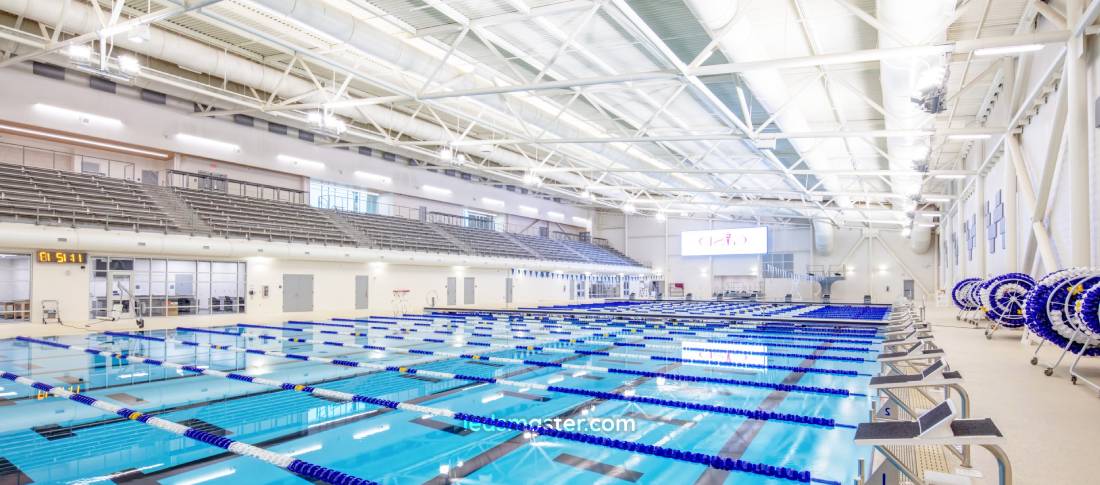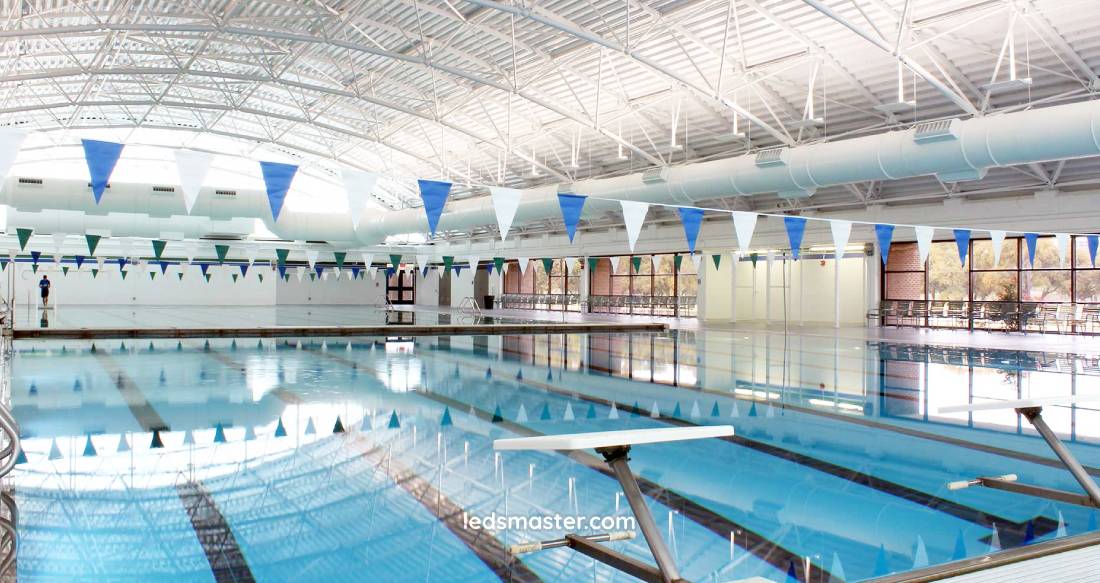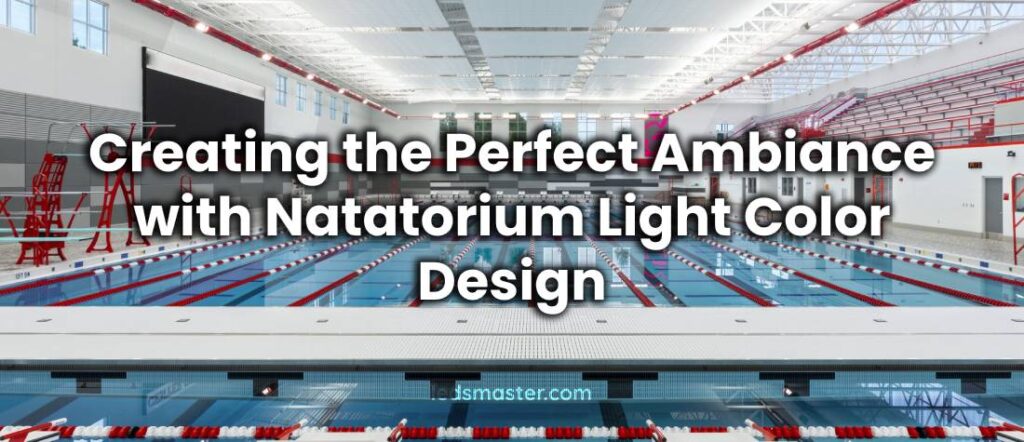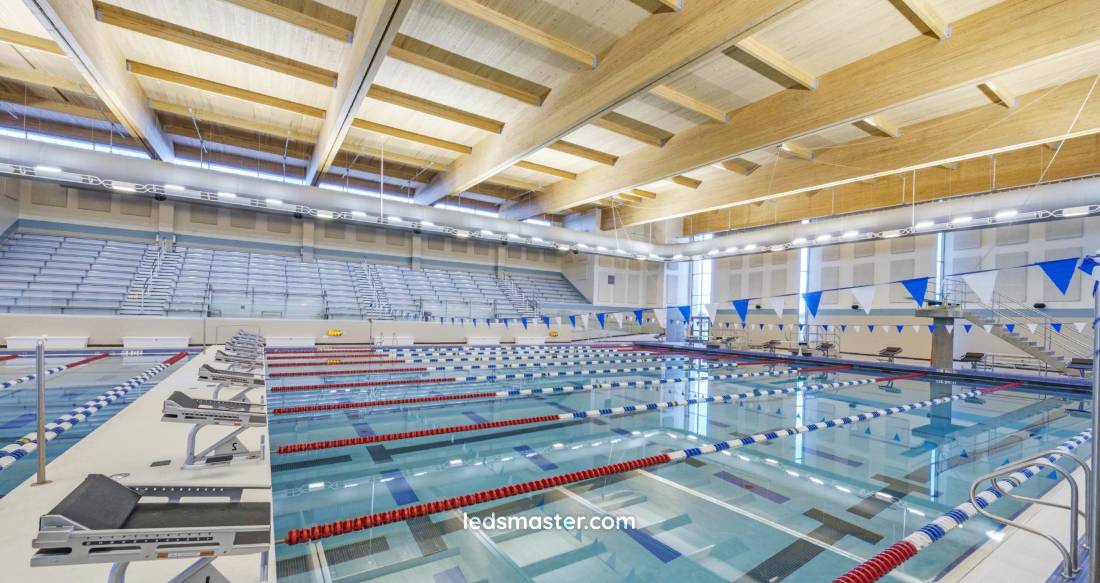In natatoriums, the design of lighting—particularly its color—can greatly influence the overall experience, from the aesthetics of the water to the mood of the swimmers and spectators. By carefully selecting and adjusting light color in a natatorium, designers can transform an otherwise ordinary space into one that promotes a sense of calm, energy, or focus depending on the intended function of the area.
Table of Contents
ToggleHow Light Color Affects Natatoriums

When designing lighting for natatoriums, one of the primary objectives is to improve the swimming experience by balancing various factors, including safety, comfort, and overall efficiency. Lighting in swimming pools must address unique challenges, such as the reflection of light on water, the specific activities taking place, and the need for visual clarity. Light color, in particular, has a profound impact on how the water looks, how people perceive their surroundings, and how swimmers feel while training or competing.
Water itself is a reflective surface, and the type of lighting used can either enhance or detract from its appearance. Additionally, light color can influence not just the visual aesthetics of the space but the overall mood and energy of those within it. Whether it’s the dynamic interplay of light on water during a swim race or the relaxing ambiance needed for recreational swimming, the design of lighting color helps to create a space that serves its intended purpose effectively.
The combination of light color, intensity, and placement all work together to create a balance that meets both functional and atmospheric needs. In competitive settings, where the focus is on performance, cool light temperatures might be used to enhance visibility, while in leisure pools, warm tones may dominate to create a more relaxed, inviting atmosphere. The color of the light can even impact the way swimmers perform, as the wrong light might hinder focus or lead to discomfort.
Visual Appeal and Water Aesthetics

The color of light affects how water is perceived by those in and around the pool, influencing both its appearance and the ambiance of the space. Light with cooler color temperatures, such as bluish hues, tends to make water appear clearer and more vibrant, giving it a clean, fresh look. These cooler tones often make water seem more inviting, especially in pools designed for competitive swimming, where clarity is vital. Water in these conditions appears to have more depth, and the cooler lighting can create a stimulating environment, encouraging swimmers to stay focused and engaged with their task.
On the other hand, warmer light temperatures, which range from soft yellows to amber tones, bring about a more soothing effect. Warm lighting makes the water appear softer and more inviting, ideal for recreational areas or pools designed for relaxation. Warm lighting encourages swimmers to feel at ease, making it conducive for social events, leisurely swims, or even therapy sessions in warmer water.
By carefully combining various light colors, designers can achieve a wide range of visual effects. For example, adding touches of warm lighting can enhance the shimmer or sparkle of the water’s surface, creating a pleasant, calming glow, while a mix of cooler and warmer lights can add depth and visual interest, making the pool’s water appear more dynamic and alive. The design of these lighting elements directly impacts the overall ambiance of the natatorium and how visitors interact with the space.
In spaces where competitive events take place, it is important to use light colors that offer accurate color rendering, ensuring swimmers and judges have clear visual cues. Daylight white light, which closely mimics natural light, helps to reveal subtle details in water quality and ensures that the conditions are clearly visible. In leisure natatoriums, however, more creative use of light color can be deployed, allowing for an immersive experience that engages visitors’ senses and enhances their enjoyment of the space.
Influence on Mood and Energy
The color of light can strongly affect the mood and energy of individuals within the natatorium, shaping their experiences in different ways. For example, warm light tones, such as soft yellow or amber, have the ability to induce relaxation, reduce stress, and foster a calm atmosphere. These tones are often used in areas designed for unwinding or socializing, such as hot tubs, saunas, or relaxation zones within the natatorium. In these settings, the warmer light creates a gentle, soothing environment where swimmers and guests can rejuvenate after a workout or a competitive event.
Conversely, cooler light tones—especially those that feature shades of blue or white—can boost energy and focus. These colors are often favored in competitive swim areas, where alertness and concentration are required. Cool lighting can help create a sense of vitality and focus, keeping swimmers energized and alert while they train or compete. Furthermore, cooler tones can provide the much-needed contrast to warmer hues, ensuring that each area of the natatorium is designed to serve its specific purpose effectively.
Strategic use of color can allow designers to set a distinct tone for different areas within the natatorium. For example, areas dedicated to intense training sessions may require brighter, cooler lighting to help maintain focus, while areas where swimmers engage in relaxation or family activities may benefit from warmer, softer tones to create a welcoming and comfortable environment. By selecting light colors according to the nature of the space, natatoriums can promote the right atmosphere for each activity or moment.
Light Color Temperature and Performance
In natatoriums, the relationship between light color temperature and performance cannot be overlooked. Light temperature refers to the warmth or coolness of light, typically measured in Kelvins (K), and it plays an important role in both functionality and aesthetics. Light temperatures with lower Kelvin values, such as 2700K to 3000K, are considered warm, while those higher up in the spectrum, such as 5000K to 6500K, are regarded as cool or daylight white.
Daylight White Light for Performance
In settings where swimmers are training or competing, daylight white light, with a temperature range of 5000K to 6500K, is often used to replicate the natural lighting found outdoors. This type of light helps enhance visibility by ensuring that colors, particularly those associated with water, are rendered accurately. Daylight white light mimics the qualities of natural daylight, which reduces the visual distortion that can sometimes occur with artificial lighting.
In competitive swimming environments, accurate light color rendering can improve the swimmer’s perception of water clarity and other environmental factors, allowing for better performance. Additionally, because this light closely replicates the qualities of natural daylight, it helps reduce eye strain, which is particularly useful for long training sessions or intense races. Daylight white light ensures that swimmers can maintain their focus for longer periods, without visual discomfort, as they interact with the pool.
Moreover, the high color rendering index (CRI) of daylight white light makes it ideal for precise observation of water conditions. Whether it’s assessing water clarity or making visual assessments during a race, having the correct light color and intensity improves the quality of these evaluations. For natatoriums where performance is prioritized, this type of lighting is a crucial element in maintaining the highest standards of accuracy and visibility.
Warm Light for Comfort and Relaxation
In contrast, warmer light temperatures, ranging from 2700K to 3000K, provide a comfortable, inviting environment, often used in areas where relaxation is a priority. These warmer tones are commonly found in leisure pools, hot tubs, or social zones within the natatorium, where individuals come to unwind after physical exertion. The soft, amber-like glow created by warm lighting can soothe the mind and body, fostering a sense of comfort and tranquility.
Even in the main pool area, the introduction of warm light in carefully selected zones can help create a balanced atmosphere. The interplay between cooler, more energetic lighting and warmer tones adds complexity and diversity to the environment. In spaces where the energy of competitive or fitness swimming might dominate, the subtle presence of warmer lighting can provide a contrast, making the space feel more balanced and less harsh.
Warm light is especially effective for fostering a relaxed ambiance in areas where swimmers are engaging in non-competitive activities, whether it’s socializing with family or enjoying a leisurely swim. By using warm light, designers can create a space that caters to the full spectrum of activities and user needs within the natatorium.
Dynamic Lighting and Color Changing Effects
Recent innovations in lighting technology have led to the introduction of dynamic lighting systems, which offer the ability to adjust color and intensity in real-time. These systems provide unmatched flexibility and allow natatoriums to create a wide variety of atmospheres, depending on the time of day or the activity taking place. The ability to change light colors throughout the day can transform the feel of the natatorium, adapting to different needs and creating more engaging environments for both swimmers and visitors.
The Use of RGB LED Lighting
RGB LED lights have become popular in natatorium design due to their versatility and the ease with which they can change color. These lighting systems can be programmed to transition through a wide range of colors, from blues and greens to reds and yellows. RGB lighting allows designers to create visually stunning effects, enhancing the pool’s ambiance and adding an element of spectacle to the space. The ability to mix and match colors enables the creation of a wide range of visual effects, each suited to different occasions.
In event-driven settings, such as swim meets or special gatherings, color-changing lights offer a powerful tool to create dramatic, eye-catching effects. For example, during a nighttime swimming event, lights could shift between cool blues and purples to highlight the water’s motion and create a relaxing, mystical vibe. Alternatively, for more vibrant events, such as a swim competition, the lighting could shift to warmer tones or even rapid color changes, adding energy and excitement to the atmosphere.
The use of RGB LED lighting enhances the experience of visitors, making the natatorium feel more alive and dynamic. The ability to customize the environment in real-time is a benefit that traditional lighting setups lack, offering natatoriums a much greater degree of flexibility and control over their ambiance.
Benefits of Dynamic Lighting in Special Events
Special events, from competitions to social gatherings, can greatly benefit from dynamic lighting. The ability to adjust the lighting to suit the event’s theme or purpose helps create an environment that aligns with the occasion. For instance, during a high-energy competition, cool, bright lights can energize both the swimmers and the spectators, creating a thrilling atmosphere. On the other hand, a more subdued and colorful lighting scheme can enhance the mood for a family event or leisure swim, making the space feel more inviting and relaxed.
By using dynamic lighting to adjust the tone of the natatorium, designers can make the space more adaptable, meeting the needs of a variety of activities. Whether it’s a competitive swim meet, an evening of socializing by the pool, or a relaxed morning workout, dynamic lighting can enhance the overall experience for everyone in the space. This ability to adjust lighting on demand is a valuable tool in creating an environment that accommodates a wide range of users and activities.
Energy Efficiency and Sustainability in Light Color Choices
While the aesthetic and functional advantages of light color design are clear, natatorium lighting must also meet practical considerations like energy efficiency and sustainability. Choosing the right light sources can help reduce the environmental footprint of a natatorium while maintaining high-quality lighting.
LED Lighting and its Benefits
LED lighting has become a popular choice for natatoriums due to its energy efficiency, long lifespan, and ability to produce a range of light colors. LED lights consume less energy than traditional incandescent or fluorescent bulbs and can be programmed for color-changing effects without a significant increase in power consumption. The use of LEDs reduces maintenance costs and the need for frequent bulb replacements, contributing to both operational savings and environmental sustainability.
Furthermore, LEDs emit less heat compared to traditional lighting sources, which can help maintain a comfortable temperature in natatoriums where heat levels may already be elevated due to humidity and water temperature. The ability to use less energy and still achieve vibrant, dynamic lighting is a major advantage for natatoriums seeking sustainable design solutions.
Smart Lighting Systems
Smart lighting systems are another option for natatoriums looking to integrate technology into their lighting design. These systems allow for precise control over the intensity, color, and timing of the lights, ensuring that energy is used efficiently while also providing flexibility. Smart systems can be programmed to adjust automatically based on occupancy or time of day, which can further optimize energy use and reduce waste.
The integration of smart lighting also enhances the functionality of dynamic lighting systems, providing an even greater level of customization to meet the needs of different activities. Whether hosting a large event or offering a calm, relaxing environment, smart lighting systems ensure that the natatorium’s lighting is both efficient and effective.
Conclusion
Lighting color and design in natatoriums are far more than an aesthetic choice. The light temperature and color used in the space directly influence the water’s visual appeal, the mood of swimmers, and the performance of athletes. By carefully selecting lighting based on the intended activity and the space’s function, designers can create natatoriums that are not only visually striking but also conducive to health, wellness, and competition. Whether opting for dynamic color-changing effects or focusing on energy-efficient LED lighting, the right lighting design can elevate the natatorium experience to new heights.


